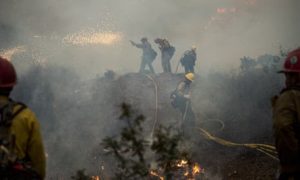Valerie Trouet — THE GUARDIAN – US EDITION
It’s time to embrace ‘good fires’ and end the misguided policy of total suppression of all wildfires
‘We have a lot to learn from indigenous people, who have centuries of “good fire” expertise.’ Photograph: Bloomberg/Getty Images
Mon 14 Sep 2020 12.50 EDT
Last modified on Tuesday 15 Sep 2020
Before this unprecedented era of mega-blazes on the US west coast, California’s forest ecosystems had a canny, ingenious way of avoiding destructive worst-case forest fire scenarios. By periodically removing the grasses, shrubs and young trees – known as the forest understory – California avoided fires growing to destructive intensities before the 20th century. The way this was done? Fire.
Every five to 15 years, groundfires would burn through the forest, killing off the undergrowth on a regular basis, thus removing the material that can act as tinder and kindle fires. Such groundfires were sparked by lightning or by indigenous people who used sophisticated burning practices to facilitate crop growing and hunting. Because the fires occurred frequently, the understory rarely had time to build up enough combustible material for the fires to reach the canopies of the mature trees – which is what causes the large, devastating fires we are seeing now. As a result, overstory trees might get wounded by the groundfires, but they would rarely get killed.
We know this, because we can still find the scars left by past groundfires in century-old Sierra Nevada trees and in stumps of trees that were cut in the late 19th century during the Gold and Silver Rush. Through dendrochronology, or tree-ring analysis, we can date these fire scars to the exact year.
In Dog Valley, near Truckee in California, for instance, I found the remainder of a tree that had been cut in 1854 and that had survived and recorded no less than 33 fires over its 300-year life span. …A fire about every 10 years, indeed. By their mere existence, such fire-scarred trees and stumps are witnesses of the non-destructive character of past forest fires on the American west coast. As part of a project to study California’s fire history, we sampled almost 2,000 fire-scarred trees and stumps in the Sierra Nevada.
What was equally arresting as finding 10 or more scars in a single tree, however, is what we did not find. Of the hundreds of living trees we sampled, only a handful had even a single fire scar in the 20th century. Centuries of frequent groundfires and fire scars ended abruptly in 1905, when Theodore Roosevelt established the US Forest Service and charged it with protecting and managing our national forests.
The 20th-century concept of forest protection embraced large-scale suppression of fires, including the harmless groundfires, the “good fires”, that played an integral role in Californian forest ecosystems. Fire suppression has been very effective over the past century in the American West, resulting in a disturbing lack of fire scars and an alarming buildup of combustible understory material, of kindling.
Through a century of fire suppression, we have turned our California forests into a tinderbox, a fire accident waiting to happen. To compound this fire danger, we have heated up our climate, making the hot California summers even hotter, the seasonally dry Californian forests even drier, and the long fire season even longer. That anthropogenic climate change, those high temperatures and their impact on fire danger, are here to stay.
We cannot reverse the anthropogenic heat and forest drought situation we have created, at least not in the short term, but we can aim to reverse the effects of our century-long fire deficit. We can aim to reverse the fire-regime shift from frequent, harmless, functional groundfires to the destructive stand-replacing crownfires that we are witnessing now.
Our strategies to embrace “good fires” will have to involve controlled fires and forest thinning, as well as wildfire management, rather than suppression. In this context we have a lot to learn from indigenous people, who have centuries of “good fire” expertise that they can bring to the planning, decision-making and management process.
It therefore does not come as a surprise that the Bureau of Indian Affairs is the federal agency with the steepest increase in prescribed fire in recent decades. Such prescribed fires are not without risk and not without smoke, but both are much smaller than under the alternative laissez-faire or fire suppression scenarios. The no-fire scenario that we have grown accustomed to over the past century is no longer available as an option. With each prescribed fire, managers therefore need to carefully balance public health and safety with forest ecological benefits.
This is not an easy task, but it is worth it. By strategically varying the time of year, the weather conditions, and the location of the prescribed fires we ignite, we can create forests that reflect the complexity and heterogeneity of bygone days. The forest understory is kept in check in such forests and unburned patches can serve as refugia for fire-sensitive plants and animals to later recolonize the burned land.
Most importantly, the mosaic-like landscape created by our carefully planned burns will disrupt the progress of uncontrolled wildfires. And who knows, future dendrochronologists might even find 21st-century fire scars in the ancient trees that we manage to preserve with our “good fire”.
- Valerie Trouet is a professor of dendrochronology at the University of Arizona. She uses tree rings to study the climate of the past and its influence on ecosystems and human systems and is the author of the broad-audience book; Tree Story: The History of the World Written in Rings (Johns Hopkins University Press, 2020)
THE GUARDIAN – US EDITION


